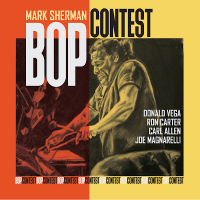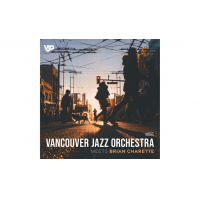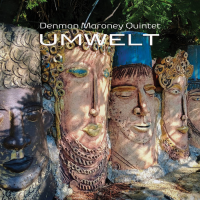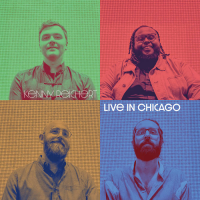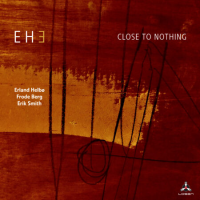Home » Jazz Articles » Multiple Reviews » National Health: National Health / Of Queues and Cures
National Health: National Health / Of Queues and Cures
Hatfield may have been a collective, with everyone sharing compositional duties, but there's little doubt that it was Stewart's writing and playing—with a uniquely sophisticated and surprisingly mature harmonic approach as advanced as any being made by American jazz artists, but possessing its own complexion—that defined the group's sound. This distinction can clearly be heard on Miller/Coxhill Coxhill/Miller / "The Story So Far..." ..."Oh Really?"'s proto- Hatfield bonus tracks, where guitarist Phil Miller, vocalist (and soon-to-be-bassist) Richard Sinclair and drummer Pip Pyle (here known as Delivery) are joined by keyboardist Steve Miller for early versions of tunes that would find their way into Hatfield's early repertoire.
 When Hatfield broke up, Stewart—ever the lofty idealist and, at least then, ignorer of practical matters like the logistical and financial challenges of touring groups larger than a quintet—had the idea of forming a grandiose nonet. The concept of two guitarists, two keyboardists, three vocalists, bass and drums was devised in collaboration with Gilgamesh keyboardist Alan Gowen. Gilgamesh, also recently broken up, was something of a diametric opposite to Hatfield, its broader improvisational aesthetic contrasting with Hatfield's rigorous compositional approach. That said, both groups still shared much in common; Hatfield may have been composition-heavy, but still featured room for some extended soloing, especially from Stewart and guitarist Phil Miller; Gilgamesh may have leaned more to jazz-centric improv, but Gowan's writing still provided a far more detailed context than the usual head-solo-head format endemic to at least a sizable amount of jazz at the time.
When Hatfield broke up, Stewart—ever the lofty idealist and, at least then, ignorer of practical matters like the logistical and financial challenges of touring groups larger than a quintet—had the idea of forming a grandiose nonet. The concept of two guitarists, two keyboardists, three vocalists, bass and drums was devised in collaboration with Gilgamesh keyboardist Alan Gowen. Gilgamesh, also recently broken up, was something of a diametric opposite to Hatfield, its broader improvisational aesthetic contrasting with Hatfield's rigorous compositional approach. That said, both groups still shared much in common; Hatfield may have been composition-heavy, but still featured room for some extended soloing, especially from Stewart and guitarist Phil Miller; Gilgamesh may have leaned more to jazz-centric improv, but Gowan's writing still provided a far more detailed context than the usual head-solo-head format endemic to at least a sizable amount of jazz at the time. And so the unwieldy National Health was born, with Stewart and Gowen enlisting ex-Hatfield and Gilgamesh guitarists Miller and Lee for the core group, as well as convincing Egg bassist/primary composer Mont Campbell to come out of his self- imposed retirement. The original idea was to recruit the three vocalists that formed The Northettes—Hatfield's angelic lyricless choir of singers Amanda Parsons, Barbara Gaskin and Ann Rosenthal—but practicality reared its ugly head almost immediately, forcing the decision to pare down to one singer, Parsons, making the germinal National Health a slightly more manageable septet. A drummer was still needed, but while Pip Pyle was the logical choice, Stewart wanted to avoid too close a tie to Hatfield, and so that idea was scrapped...at least initially.
Following the painful search for a drummer, hilariously documented by Stewart in the liners to the now out-of-print Complete (East Side Digital, 1990)—a compilation of National Health's first two albums, National Health (1978) and Of Queues and Cures (1978), as well as 1982's D.S. Al Coda, its posthumous tribute to Gowen (who passed away from leukemia in 1981) and a couple of bonus tracks—the group managed to enlist ex-Yes and King Crimson drummer Bill Bruford. Bruford, an increasingly in-demand player who was an ideal choice for the group's knotty writing, wasn't able to make a full commitment but was able to work with the band throughout 1975 and most of 1976, and was a part of the first gigging line-up that also recorded a number of demos and BBC sessions through to the fall of 1976, documented on Missing Pieces (East Side Digital, 1996).
 At that point National Health was still a compositional collective; in fact, with the returning Campbell the emphasis in the early National Health repertoire remained on his unmistakably challenging (and influential) writing, where meters often shifted with each new bar and even the shortest composition was an epic of episodic intent. But trouble was already in the air. Lee left the band following the group's first tour, replaced temporarily by ex-Khan/Gong guitarist Steve Hillage—the first in what would be many personnel shifts in a still nascent band.
At that point National Health was still a compositional collective; in fact, with the returning Campbell the emphasis in the early National Health repertoire remained on his unmistakably challenging (and influential) writing, where meters often shifted with each new bar and even the shortest composition was an epic of episodic intent. But trouble was already in the air. Lee left the band following the group's first tour, replaced temporarily by ex-Khan/Gong guitarist Steve Hillage—the first in what would be many personnel shifts in a still nascent band. Times continued to be tough. Stewart and Gowen were ready to record National Health's first album, but by 1976 the major record labels—initially tremendous supports—had begun to desert the progressive scene as the first whiffs of punk began to waft out of England. Even Virgin, a label founded on progressive rock acts including Hatfield, Mike Oldfield, Gongzilla and Henry Cowell, had no interest in what Stewart and Gowen had to offer. With gigs in short supply and no recording deal in sight, National Health continued as a sextet, with the two keyboardists, Miller, Campbell, Bruford and Parsons.
By 1977, with Bruford off to work on composition and record his first solo album, Feels Good to Me (Winterfold, 1978), in addition to forming progressive rock supergroup UK, Stewart finally buckled and brought Pyle into the fold. Even more serious, however, was the departure of Campbell who, as Stewart writes in Complete, had ..."been forcibly reminded of the things that had caused him to quit the rock scene in 1972." Soon after Campbell's spot was filled by ex-Gilgamesh bassist Neil Murray, Parsons left, followed by Gowen. Losing one of the group's two co- founders seemed a crushing blow; even with the group dropping Campbell's writing and focusing exclusively on his own compositions and those of Stewart's, the revolving door of personnel and lack of forward motion finally took its toll.
It was the remaining line-up, now a quartet of Stewart, Miller, Murray and Pyle, that was finally able to secure a record deal with Charly Records' Affinity label. The road to National Health's eponymous first album may have been a long and rough one, but it didn't diminish its strength in the least, nor did the fact that its core line-up was three-quarters of Hatfield and the North. With Stewart contributing the lion's share of the writing (only "Brujo" was written by Gowen, and the closer, "Elephants," was a collaboration between him and Stewart), there was little doubt that National Health was his band, and the group's two 1978 releases—even with later compositional contributions from Miller, Pyle, and ex-Henry Cow bassist John Greaves, who replaced Murray for Of Queues and Cures—came as close to reflecting what a Dave Stewart solo album of the time might have sounded like.
With Complete out of print for some time, and earlier single disc releases of National Health's first two albums both inferior in sound and also unavailable, it's good news that England's Esoteric Records—a label that's been rescuing no shortage of terrific British progressive music out of obscurity and remastering it with as good a sound as is possible, given the limitations of its source— has now given both National Health and Of Queues and Cures the star treatment, sounding better than they ever have and featuring new liner notes by Sid Smith, best known as the documenter of King Crimson and author of In the Court of King Crimson (Helter Skelter, 2001).
 National Health
National Health National Health
Esoteric Records
2009 (1978)
While National Health had been gradually and unceremoniously trimmed down to a quartet, for its first release Stewart still enlisted Gowen and Parsons to provide some indication as to what the expanded National Health would have sounded like. But more than that, he enlisted woodwind multi-instrumentalist Jimmy Hastings, well-known to Caravan and Hatfield and the North fans, and percussionist John Mitchell to flesh the group out to an octet that allowed for the expanded orchestration he and Gowen had in mind when they formed the group three years prior. While some consider the album to be something of a departure from the Canterbury sound—a distinctly British sounds that meshed complexity with self-effacing humor and unmistakable lyricism—it may appear somewhat more serious in tone than its follow-up, Of Queues and Cures, but it nevertheless retains most of the markers that make it another defining moment in Canterbury history.
Opening with Stewart's epic, the 14-minute "Tenemos Roads" (the only track to feature lyrics), all the qualities of Stewart's writing are there: the atmospheric intro; the pulsating rhythm driving a theme that's surprisingly singable, leading into an organ solo by Stewart that proves he's as strong and focused an improviser as he is a writer; and a first salvo from Miller that demonstrates his equally melodic yet ever-oblique ability to always play the right note, albeit one that's the polar opposite of what might be expected. The vocals don't show up until nearly six minutes in, and when they do they're over a far more complex underpinning, with time signatures and dynamics shifting continuously, yet still making complete and utter sense and never feeling forced or overly considered. And despite the size of the group and the occasional density of the textures, the arrangement never feels busy or over-wrought. It's that quality that has always separated Stewart's writing—and that of his co-horts—from so much of the progressive music of the day. Even as intentionally bombastic as the ending of "Tenemos Road" is, it's somehow delivered with the crack of a smile, a hint of a grin.
Gowen's "Brujo" begins lighter in tone, a contrapuntal mix of ideas that's nearly classical in its construction, with piano, Moog synthesizer, bass, guitar and voice interweaving and ultimately leading into a pastoral section where Hastings' flute blurs the line between form and freedom. Even as Parsons' voice takes over, blending into a creative new mix with Miller's long, sustaining guitar lines, the piece morphs into a buoyant middle section driven by Murray's lithe playing—he may have gone onto work with metal bands including Whitesnake and Black Sabbath, but he was and remains a remarkably flexible and intuitive player—where first Gowen and then Stewart take extended solos. At a time when Moog synthesizers were being used for sounds that would often later be considered cheesy, Gowen's tone remains appealing and less time- stamped. Again, Miller weaves his way without ever playing a conventional guitarist line; like the rest of these musicians, Miller remains a sadly undervalued artist, who continues to create compelling music with his In Cahoots band, most recently on the ambitious Conspiracy Theories (MoonJune, 2007).
Stewart's "Borogoves" begins with a brooding solo feature for Murray. Stewart's ability to create music that's undeniably difficult but still retains an unfailing sense of lyricism, is again on display, as Miller and Gowen orbit around a central kernel, only to lead to another resilient section where the various instruments intertwine, move apart and come together with unerring accuracy. Individual themes push to the forefront and background in combinations and permutations that surely required great consideration, yet feel completely natural to the ear.
As the album draws to a close with another 14-minute epic, the Stewart/Gowen collaboration "Elephants," there are hints of the more liberal free-play that Gowen would be pursuing in both Soft Heap (a collective with Pyle, and ex-Soft Machiners, bassist Hugh Hopper and saxophonist Elton Dean) and, indeed, National Health circa 1979, when Stewart left the band and he rejoined Miller, Greaves and Pyle for a 1979 tour that was ultimately documented on Playtime (Cuneiform, 2001). Still, form gradually asserts itself as the piece moves inexorably, through Gowen's most imaginative Moog solo of the disc, towards a reprise of the theme from "Tenemos Roads" that leads to an atmospheric ending that brings the album full circle. Quoting from Mont Campbell's "Agrippa," and "Zabaglione— both heard on Missing Pieces—and inspired by the bassist's compositional methods, it's by no means the first time Stewart has used Campbell's ideas but is a reminder, yet again, of Campbell's under-appreciated influence on the Canterbury scene.
National Health was ultimately regarded as inferior to Of Queues and Cures—and certainly the sound isn't as rich or clear, and the follow- up disc returns to a more decidedly wry bent that makes it a more direct follow-up to Hatfield and the North—but revisiting the disc over 30 years later reveals a strength in composition, improvisation and orchestration/arrangement that makes it another high point in the careers of everyone involved, but especially Stewart, who after leaving National Health would give the progressive arena one more solid kick at the can with Bill Bruford's group, Bruford, before deserting it entirely to begin a series of pop albums for adults. Still, with considerable distance from a time when he struggled to get his music heard, his most recent pop album with longtime partner/singer Barbara Gaskin, Green and Blue (Broken Records, 2009), signals a new consolidation of accessible pop songs and more progressive concerns.
 National Health
National Health Of Queues and Cures
Esoteric Records
2009 (1978)
With John Greaves replacing the departing Neil Murray, and neither Gowen or Parsons involved, Of Queues and Cures may be a more collective effort- -Stewart contributes three of the album's seven tracks, Pyle two (well, sort of; more of that in a moment) and one each by Miller and Greaves—but it's still dominated by Stewart's powerful playing and unmistakable harmonic construction. Opening with "The Bryden 2-Step (for Amphibians) (Part One)"—which possesses such a strong melody that Stewart would reprise it two years later in "Land's End" from Bruford's swan song, Gradually Going Tornado (Winterfold, 1980), that would also prove to be Stewart's final progressive gasp for three decades—there's a strength about the new line-up that makes its short-lived duration all the more unfortunate. Episodic in construction, with more things going for its nine minutes than most entire albums have, it's brighter, more committed and more powerfully played than anything on the group's first effort. And while Greaves has spoken about uncertainty and lack of confidence in joining the group and tackling National Health's knotty compositions, he's a perfect fit; as capable as Murray at navigating its rough waters while being an even more melodic soloist, as he proves on the opening track's fade-out.
Stewart's "Collapso," a track revisited by Stewart in 1990 for Complete's "The Apocalypso," introduces a new texture to the group: Selwyn Baptiste's steel drums. But this is no calypso tune; in fact, there's no hint of the Caribbean to be found anywhere, as yet another challenging context with an unforgettable melody leads into even greater contrapuntal complexity. Given, at this point, that American bassist Jaco Pastorius was using steel drums in his own group, it's hard to say if that was an influence on Stewart's choice to bring the texture into National Health. But regardless, it's a different space, as the song evolves into an unrelenting, high velocity passage that sets up a visceral fuzz bass solo from Greaves before returning to its theme to close.
Coming from Henry Cow, it's no surprise that Greaves' contribution, "Squarer for Maude," possesses some of the Rock in Opposition (RIO) qualities that took Cow away from its initial Canterbury roots into a more abstruse, new music direction. The energy, color and overt pulse may speak rock, but the instrumentation and depth of melodic interaction marks this as more a contemporary chamber piece. Guests including cellist Georgie Born—Greaves' replacement in Cow—oboist Keith Thompson and stalwart clarinetist/flautist Jimmy Hastings, create a collective tapestry different than anywhere else on the disc, and the brief narrative appearance of Peter Blegvad (co-founder of Slapp Happy, who merged and then de-merged with Henry Cow after its 1975 Virgin release In Praise of Learning) makes the departure complete. Still, Stewart's closing organ solo and unmistakable voicings throughout, along with Pyle's more fervent rhythms (as opposed to Cow drummer Chris Cutler's more loosely interpretive approach) tie the tune to the National Health sound, even if it represents something of a departure; a direction that would have been interesting to explore, had the group managed to remain together.
Miller's "Dreams Wide Awake" may seem like a guitarist's composition at first—based, as it is, around a driving riff that creates a rock-hard foundation for one of Stewart's most memorable solos of this, or any disc. Stewart describes his reckless abandon—matched only, perhaps, by Frank Zappa's equally unfettered solo on Over-Night Sensation's "Zombie Woof" (Rykodisc, 1973)—as "a red rag to a bull—with my volume control set hard over on '10' and lashing out at every foot pedal within my reach. I commenced a Genghis Khan-like attack on my organ. Smashing my arms down on the keys, I ripped out valves, wires and strings of components from the Hammond's interior while the rest of the band and engineers watched in aghast. In the shocked silence at the end of the take I knew I'd gone too far...but by some oversight the solo remains." And it's a good thing it does. Any suggestions that Stewart was incapable of a full-out body slam solo are laid to waste here.
But when Stewart's solo is over, Miller takes the tune into territory as episodic as anything Stewart has written, combining oblique melodies with near-funk and a second solo from Stewart that, when compared to his initial barrage, seems almost polite...but only almost. Whether he's tearing the guts out of his organ or seated more civilly, the underlying melodicism remains. And Miller, who finally takes a heavily distorted solo towards the song's end, continues to prove, as ex-Soft Machine drummer/vocalist Robert Wyatt has suggested, that he'd "rather play a wrong note than a note that somebody else had ever played." In a large repertoire of original composition, "Dreams Wide Awake" remains one of Miller's finest.
Pyle gets two compositions back-to-back. On the more song-like "Binoculars," the witty but equally dark pen that contributed "Fitter Stoke Has a Bath" to Hatfield's The Rotters Club remains as sharp as ever, even as it descends into complete freedom before gradually turning pastoral for a return to its initial theme across nearly 12 minutes of keys, guitars and horns. But it's the brief "Phlakaton" that, perhaps, stands out as the late drummer's most memorable writing—if only for a mere nine seconds. Pyle rarely, if ever, took a drum solo, and so to increasing demand for one, "Phlakaton" is the answer. That an entire audience in Toronto, Canada, memorized Pyle's vocal interpretation of a drum solo in 1979, documented on Missing Pieces, is remarkable in itself: "Phlak, phlakka phlakka phlakaton cash. Ker- chaffa, ker-chaffa, oum ka ka oum-er ka kaf dof, flibbet, flibbet, flibbet, flibbet, raka taka raka taka BISH!"
It's a terrific lead-in to Stewart's closer, "The Bryden 2-Step (for Amphibians) (Part Two)," which features (for the time) a rare synthesizer solo from a keyboardist who was rarely heard on the relatively nascent instrument, even while those around him succumbed more heavily to the lure of sounds that often sound dated today. But Stewart's ear for tone meant a texture that remains fresh 30 years later, leading into a reprise of the powerful melody that drove "Part One" as, once again, rather than ending in great drama, the group fades in greater atmospherics, turning yet another album into a full-circle experience.
 Stewart's departure before National Health's final tour changed the complexion of the band, from one dedicated to complex writing and solos largely over firm structures to a more open-ended improvising unit with the brief return of Gowen. Still, after Gowen's passing, when the group reconvened for an album dedicated to the late keyboardist's compositions, D.S. Al Coda, it retained the strong voice of Stewart in the arrangemements, even on material that wasn't of his own making.
Stewart's departure before National Health's final tour changed the complexion of the band, from one dedicated to complex writing and solos largely over firm structures to a more open-ended improvising unit with the brief return of Gowen. Still, after Gowen's passing, when the group reconvened for an album dedicated to the late keyboardist's compositions, D.S. Al Coda, it retained the strong voice of Stewart in the arrangemements, even on material that wasn't of his own making. National Health and, shortly afterwards, Bruford, may have been Stewart's last progressive efforts. As dominant and defining a force in both groups as he was, it would be unfair to dismiss the collective sound created by both groups' participants. Still, these final recordings—along with D.S. Al Coda—represent the highest water marks in Stewart's career; one that had an ever-rising trajectory. That he's now reconciling his progressive interests with a desire to create accessible pop songs is great news for fans who've missed him on a scene that, thanks to the internet, is finally surging again in popularity.
Esoteric's timely reissues of these two National Health discs are a strong reminder of just how important Stewart was at a time when there were few, if any rules and it was not just acceptable, but demanded to pursue all avenues to their logical conclusions...and, often, beyond. Esoteric's forthcoming Hatfield and the North reissues will, no doubt, bolster this belief even further, providing further evidence that it was and remains possible to create music of great compositional depth without resorting to excessive self-indulgence or over-consideration. As significant as the contributions of everyone in National Health are to these two releases, it's equally true—as was the case with Hatfield and was also proven when Gowen took over the reins in National Health— that National Health would have been a completely different affair, had Stewart not only been a major participant, but its de facto leader.
Tracks and Personnel
National Health
Tracks: Tenemos Roads; Brujo; Borogoves (excerpt from Part Two); Borogroves (Part One); Elephants.
Personnel: Dave Stewart: organ, electric and acoustic piano, clavinet (3, 4); Phil Miller: guitar; Neil Murray: bass; Pip Pyle: drums, cowbell (1), tambourine (1), gong (1), glockenspiel (2, 5), finger cymbals (2), shaker (2), bells (2), pixiephone (5); John Mitchell: percussion (1), temple blocks (2), guava (2); Alan Gowen: Moog, electric piano, acoustic piano (2, 5); Amanda Parsons: vocals; Jimmy Hastings: flute, bass clarinet (1), clarinet (3, 4).
Of Queues and Cures
Tracks: The Bryden 2-Step (for Amphibians) (Part One); The Collapso; Squarer for Maude; Dreams Wide Awake; Binoculars; Phlakaton; The Bryden 2-Step (for Amphibians) (Part Two).
Personnel: Dave Stewart: organ (1-5, 7), electric piano (1-5, 7), acoustic piano (1-4, 7), minimoog (3, 4); Phil Miller: guitar; John Greaves: bass, piano innards (3), crooning (5); Pip Pyle: drums, percussion (3), handclaps (3), breakage (2); Georgie Born: cellos (1, 3, 7); Paul Nieman: trombones (1, 5, 7); Phil Minton: trumpets (1, 5, 7); Selwyn Baptiste: steel drums (2); Jimmy Hastings: clarinets (3, 5), bass clarinets (3), flute (5); Keith Thompson: oboe (3, 5); Peter Blegvad: voice (3).
Tags
National Health
Multiple Reviews
John Kelman
Soft Machine
Alan Gowen
Bill Bruford
Gong
Henry Cow
Hugh Hopper
Elton Dean
Jaco Pastorius
Frank Zappa
PREVIOUS / NEXT
Support All About Jazz
 All About Jazz has been a pillar of jazz since 1995, championing it as an art form and, more importantly, supporting the musicians who make it. Our enduring commitment has made "AAJ" one of the most culturally important websites of its kind, read by hundreds of thousands of fans, musicians and industry figures every month.
All About Jazz has been a pillar of jazz since 1995, championing it as an art form and, more importantly, supporting the musicians who make it. Our enduring commitment has made "AAJ" one of the most culturally important websites of its kind, read by hundreds of thousands of fans, musicians and industry figures every month.







